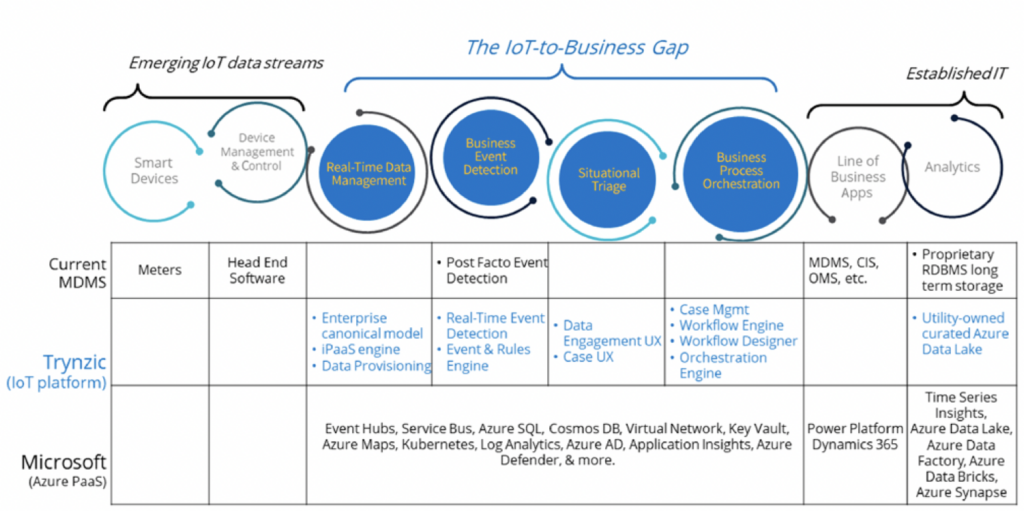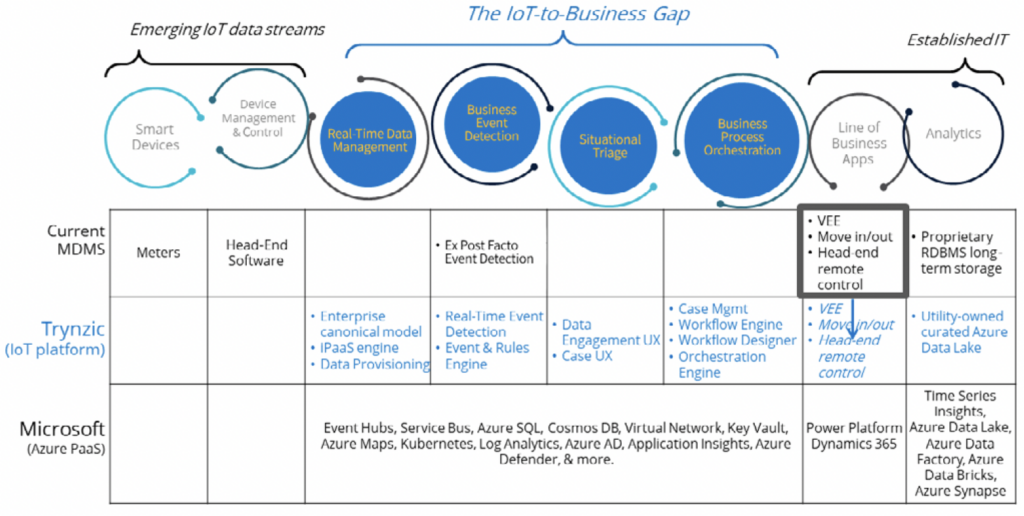IoT Business Platforms vs. MDMS
Click here to download this white paper as a PDF.
A New Software Strategy Contrasted with Incumbents
The value proposition of an IoT business platform for utilities is best understood in context of the current state of progress from smart meters to the smart grid.
Advanced Metering Infrastructure has been on the scene for over a decade. Head-end software systems, MDMS systems, and analytics/reporting products have had over a decade to react to the sea change that AMI meter technology represents in terms of data. Sadly, across the industry, utilities have not applied innovation toward this data to advance use cases that represent the “smart grid”.
About IoT Business Platforms
Ten years after the introduction of smart meters, why don’t we have the smart grid?
Sensor telemetry representing current grid conditions is bypassing business processes of the utility. Across the industry, this data flows from the grid to data warehouses, where it is used for ex post facto grid condition analysis.
At Trynzic, we created a software solution that provides business processes informed by current grid conditions. We did this by creating what is, to our awareness, the first full-fledged IoT business platform for utilities — Trynzic for Utilities. We have built Trynzic for Utilities upon Microsoft Azure PaaS for purposes of scale, security, and cost efficacy for utilities.
Let’s compare this new software solution to the traditional MDMS.
Why Your MDMS Isn’t Enough
When first introduced to the concept of a Utility Data Platform (UDP), many ask if it’s similar to an MDMS or if their MDMS can be customized to do what a UDP does. The short answer is no. The long answer originates in the development of an MDMS and other traditional utility applications. Below we compare how that development affects the journey leading to a fully orchestrated utility business.

IoT Business Platforms vs. MDMS
Trynzic for Utilities is not an alternative to the AMI head-end, MDMS, or analytics solutions. We are complementary, but in a very important way that relates to the future of the industry.
Three constructs underpin an IoT business platform:
- high-volume, high-velocity data processing,
- orchestration of business response processes,
- timing (real-time or near).
Timing and Volumes of Data
The US grid has been called the largest and most complex machine ever invented by humans, and as it transitions to digital, we will see emerge one of the largest streams of data ever.
Legacy software providers prevalent within utilities have codelines born in a pre-IoT era with client-server designs unable to handle the volume and timing needs of the coming digital (smart) grid.
Advancing from Smart Meters to Smart Grid
Figure 1 presents a taxonomy of software capabilities required to bridge the world of high-volume, highvelocity data IoT with the traditional business-application enabled operations of a company.

Figure 1: A software capability taxonomy for adding IoT into businesses.
The takeaway from Figure 1 is that MDMS applications are a line-of-business application that offers desirable process automation (e.g., validation, estimation, and editing), but their original mission did not include addressing the IoT data challenge.
Conversely, IoT business platforms are designed specifically to the high-volume, high-velocity data problem and provide real-time interpreted results to business processes.
IoT Platform or MDMS: Which Direction Is Right for Utilities?
Indications are that the utility industry is at an inflection point with respect to digital transformation and the smart grid, with the litmus question being, “Is observability of current grid conditions required?”
With DER, electrification, energy transition, and evolving customer expectation all imply dramatic increases in grid-edge complexity, so IoT capabilities become increasingly more relevant.
This leaves utilities a choice:
- Continue the ongoing bet that legacy MDMS software will successfully extend into the IoT Business Platform category, or …
- Adopt an IoT Business Platform. The history of software as it applies to underlying architectures is useful here.
Trynzic is biased in this choice. However, we are so confident in our technology that we have invested significantly in the platform that we now offer to utilities.
MDMS products are built upon traditional client-server, relational database (RDBMS) technologies. IoT Business Platforms are not similarly constrained because a single “server” is not practical for processing such volumes of data in real time. Trynzic for Utilities resides in the “serverless” (PaaS) portion of Microsoft’s Azure cloud. This means better performance, lower cost, and more comprehensive data security.
Codelines that go back 10, 15, or 20+ years will not transform architecturally to meet high-volume, highvelocity data; nor will they evolve into the system-of-system orchestration role to fully connect the inbound IoT data stream to business processes.
However, Trynzic understands utilities cannot get rid of their MDMS functions altogether. That is why our software is designed to be compatible with and complementary to MDMS applications.
Trynzic’s Feature Roadmap
We see an emerging pattern of utilities pursuing MDMS applications to address IoT requirements (long-term storage, grid monitoring, etc.)
We assume this is because the MDMS genre seems the most applicable and able to meet these new requirements based on history and prior knowledge. In reaction to this market trend, Trynzic will incorporate mainstream MDMS line-of-business features into Trynzic for Utilities in the near future so utilities do not have to suboptimize the future potential of their investment simply because of historical application boundaries.
Trynzic is perfectly fine coexisting with MDMS applications, but we want to offer a pathway for utilities that want to service both missions within a single software solution.

Figure 2: Adding traditional MDMS features to Trynzic for Utilities.